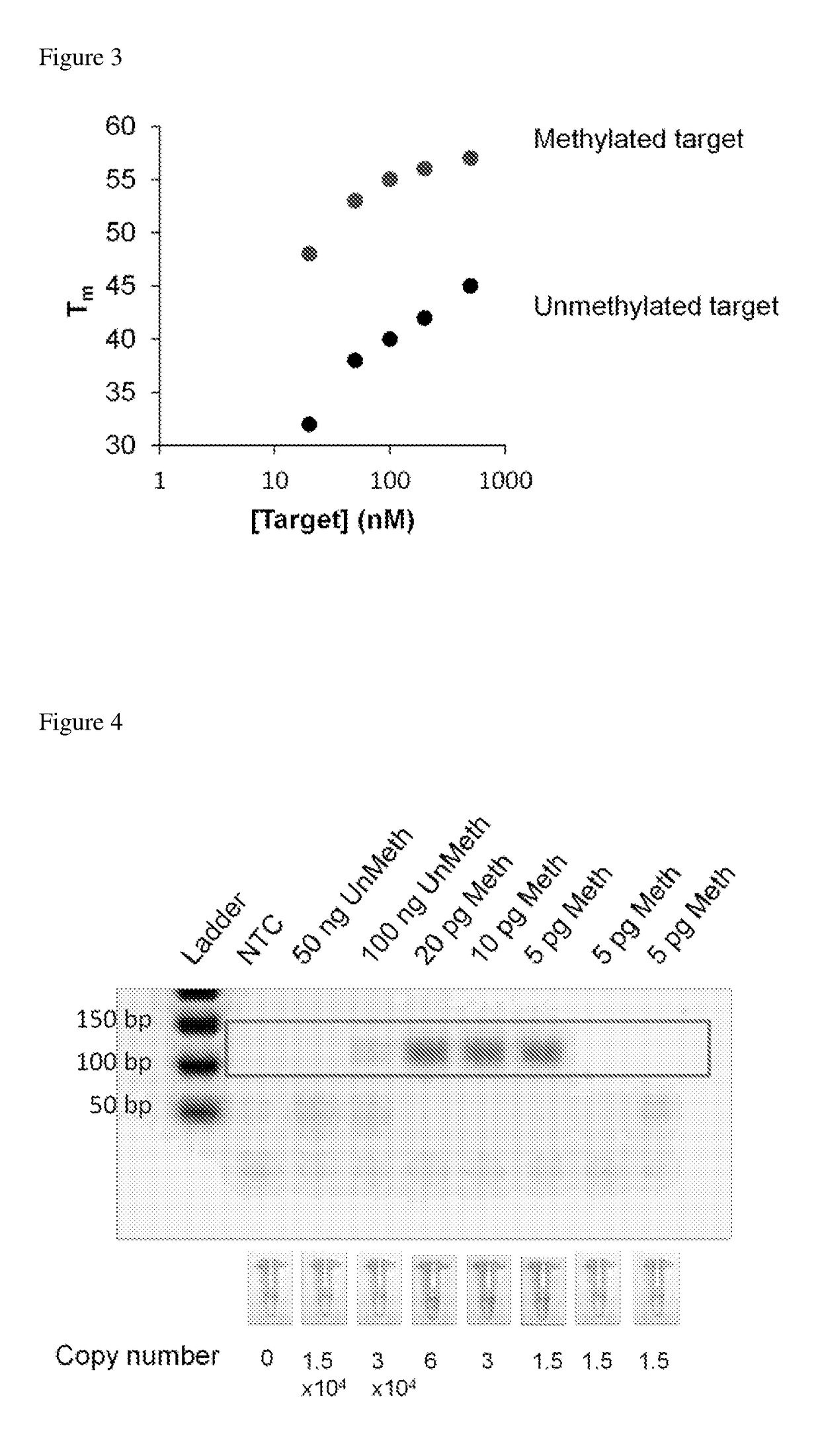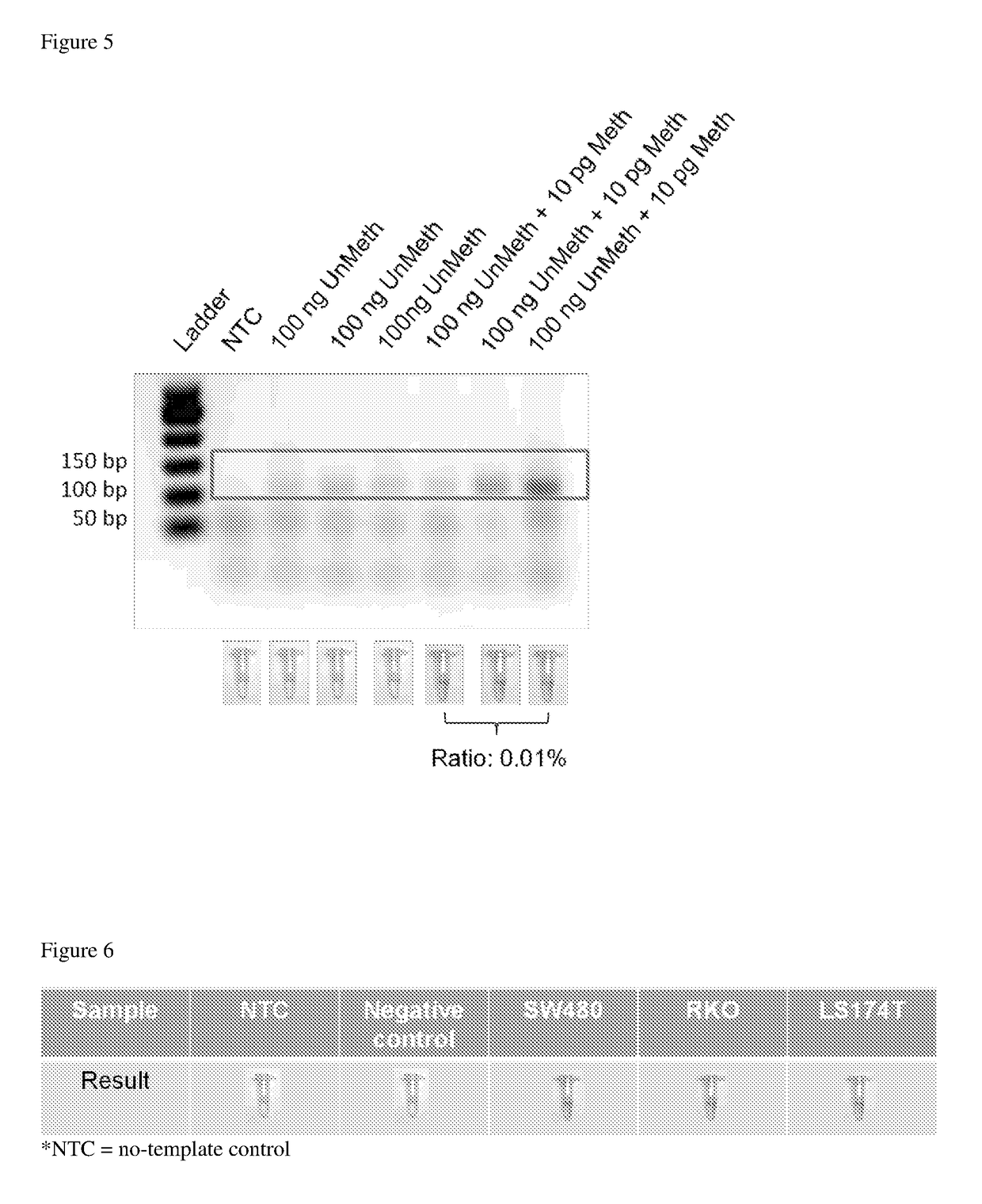Determination of nucleic acid methylation
a nucleic acid methylation and determination technology, applied in the field of methods and kits for detection of dna methylation, can solve the problem of difficult to gauge the epigenetic change of rare circulating tumor cfdna in a large background of normal dna
- Summary
- Abstract
- Description
- Claims
- Application Information
AI Technical Summary
Benefits of technology
Problems solved by technology
Method used
Image
Examples
example 1
Evaluation
[0082]To characterize the nanoprobes, Tm data were measured in the presence of synthetic DNA samples over a broad concentration range of 20 nM to 500 nM (FIG. 3). The synthetic DNA sequences represent the target regions of methylated and unmethylated SEPT9 genes after bisulfite conversion (Table 2). At room temperature (˜25° C.), the nanoprobes were stabilized by ≥20 nM of the DNA samples. With the increase in DNA target concentration, Tm increases. The reduction of Tm induced by 4 G / T mismatches between the unmethylated target and the probe was ˜15° C.; this allowed for highly specific detection of the methylated target.
example 2
formance Evaluation
[0083]The sensitivity and specificity of the assay were tested by using methylated and unmethylated human genomic DNA (gDNA) samples with concentrations of 5 pM to 100 nM (corresponding copy numbers are 1.5 and 3×104, respectively). FIG. 4 shows that the aPCR produced amplicons consistently for methylated gDNA down to 3 copies. Accordingly, the nanoprobe assay generated positive results. For the samples with even lower concentrations, random positive results were obtained.
[0084]Unmethylated gDNA was the interfering background of the assay. The aPCR did not produce specific amplicons for the unmethylated gDNA with concentration up to 50 nM. However, for unmethylated gDNA of 100 nM, amplicon band appeared in the gel electrophoresis analysis, indicating the non-specific amplification of the unmethylated sequences. In this case, the specificity of the methylation-specific primers and the effect of blockers were unable to prohibit the aPCR from generating detectable am...
example 3
of Cell Line Samples
[0086]gDNA extracted from several colorectal cancer cell line samples, such as SW480, RKO and LS174T, was also tested. As reported in the literature, these cell lines are all hypermethylated in the promoter region of the SETP9 gene. The assay showed positive results in the methylation analysis for all the samples (FIG. 6).
[0087]A highly sensitive and specific assay for SEPT9 gene promoter methylation has been developed. The assay is able to detect 0.01% methylated DNA in the background of unmethylated sequences (i.e. ˜3 copies of methylated DNA in 100 nM of unmethylated sequences). This assay would be suitable for methylation analysis of cfDNA in blood samples.
[0088]The invention has been described broadly and generically herein. Each of the narrower species and subgeneric groupings falling within the generic disclosure also form part of the invention. This includes the generic description of the invention with a proviso or negative limitation removing any subjec...
PUM
| Property | Measurement | Unit |
|---|---|---|
| Tm | aaaaa | aaaaa |
| size | aaaaa | aaaaa |
| size | aaaaa | aaaaa |
Abstract
Description
Claims
Application Information
 Login to View More
Login to View More - R&D
- Intellectual Property
- Life Sciences
- Materials
- Tech Scout
- Unparalleled Data Quality
- Higher Quality Content
- 60% Fewer Hallucinations
Browse by: Latest US Patents, China's latest patents, Technical Efficacy Thesaurus, Application Domain, Technology Topic, Popular Technical Reports.
© 2025 PatSnap. All rights reserved.Legal|Privacy policy|Modern Slavery Act Transparency Statement|Sitemap|About US| Contact US: help@patsnap.com



